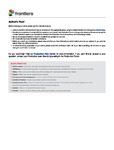Patient-to-Patient Interactions During the Pain Management Programme: The Role of Humor and Venting in Building a Socially Supportive Community
| dc.contributor.author | Anil, Krithika | |
| dc.date.accessioned | 2022-05-10T13:38:59Z | |
| dc.date.issued | 2022-04-27 | |
| dc.identifier.issn | 2673-561X | |
| dc.identifier.issn | 2673-561X | |
| dc.identifier.other | 875720 | |
| dc.identifier.uri | http://hdl.handle.net/10026.1/19212 | |
| dc.description.abstract |
<jats:sec><jats:title>Objectives</jats:title><jats:p>Social support is most positively perceived when there is an optimal match between a patient's need for communication and the purpose of their interaction. Maladaptive communication patterns may inhibit social bonding or mutual support, negatively impacting clinical outcomes. This study aimed to identify how people with chronic pain naturalistically converse together about their pain in the context of a Pain Management Programme (PMP).</jats:p></jats:sec><jats:sec><jats:title>Methods</jats:title><jats:p>Seven participants (4 females; 3 males) with ongoing chronic pain who were attending a PMP in a regional hospital in the United Kingdom were audio/video recorded during breaks in their PMP. Interactions were transcribed using Jeffersonian Transcription and analyzed using Conversation Analysis.</jats:p></jats:sec><jats:sec><jats:title>Results</jats:title><jats:p>Two conversational mechanisms were identified: (1) <jats:italic>Conversational humor</jats:italic>; and (2) <jats:italic>A venting cycle</jats:italic>. Participants used their pain-related experiences construct a motive for a joke, then proceeded to deliver the joke, which initiated a joke return from observers. The sequence was completed by a collaborative punchline. In the venting cycle, an initial complaint was escalated by the sharing of comparable experiences, after which the vent was concluded through a joke punchline, acting as a pivot to move the conversation forwards, terminating the venting.</jats:p></jats:sec><jats:sec><jats:title>Conclusions</jats:title><jats:p>Humorous interpersonal interactions about chronic pain provided a forum for social support-building within the PMP. Humor was affiliative and built social collaboration, helping individuals to together make sense of their pain in a prosocial atmosphere, approaching pain-related experiences with levity. Patient-to-patient interactions within the PMP were strongly prosocial and inclusive, potentially facilitating enhanced PMP clinical outcomes through collaboration.</jats:p></jats:sec> | |
| dc.format.extent | 875720- | |
| dc.format.medium | Electronic-eCollection | |
| dc.language | eng | |
| dc.language.iso | en | |
| dc.publisher | Frontiers Media | |
| dc.subject | chronic pain | |
| dc.subject | conversation analysis | |
| dc.subject | interaction | |
| dc.subject | interpersonal | |
| dc.subject | peer | |
| dc.subject | qualitative | |
| dc.subject | social support | |
| dc.title | Patient-to-Patient Interactions During the Pain Management Programme: The Role of Humor and Venting in Building a Socially Supportive Community | |
| dc.type | journal-article | |
| dc.type | Journal Article | |
| plymouth.author-url | https://www.ncbi.nlm.nih.gov/pubmed/35571144 | |
| plymouth.volume | 3 | |
| plymouth.publication-status | Published online | |
| plymouth.journal | Frontiers in Pain Research | |
| dc.identifier.doi | 10.3389/fpain.2022.875720 | |
| plymouth.organisational-group | /Plymouth | |
| plymouth.organisational-group | /Plymouth/Faculty of Health | |
| plymouth.organisational-group | /Plymouth/Faculty of Health/School of Health Professions | |
| plymouth.organisational-group | /Plymouth/REF 2021 Researchers by UoA | |
| plymouth.organisational-group | /Plymouth/REF 2021 Researchers by UoA/UoA03 Allied Health Professions, Dentistry, Nursing and Pharmacy | |
| plymouth.organisational-group | /Plymouth/Users by role | |
| plymouth.organisational-group | /Plymouth/Users by role/Academics | |
| dc.publisher.place | Switzerland | |
| dcterms.dateAccepted | 2022-03-21 | |
| dc.rights.embargodate | 2022-5-14 | |
| dc.identifier.eissn | 2673-561X | |
| dc.rights.embargoperiod | Not known | |
| rioxxterms.versionofrecord | 10.3389/fpain.2022.875720 | |
| rioxxterms.licenseref.uri | http://www.rioxx.net/licenses/all-rights-reserved | |
| rioxxterms.type | Journal Article/Review |


